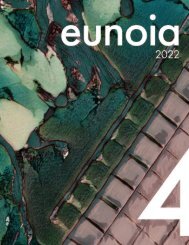WSU EUNOIA Volume II
Washington State University, School of Design + Construction student work for the academic year of Summer 2020 - Spring 2021
Washington State University, School of Design + Construction student work for the academic year of Summer 2020 - Spring 2021
Create successful ePaper yourself
Turn your PDF publications into a flip-book with our unique Google optimized e-Paper software.
CORRECTIONAL CENTERS
THROUGH THE ‘BROADACRE’ LENS
CELESTINE CANUTE
ISSUES IN ARCHITECTURE
Figure 1: Rehabilitation through
gardening practiced at H-UNIT at
San Quentin State Prison 7
Looking into one of the aspects of
present-day’s populated society
it is evident that mass production
is used as a common method
that balances the growing
supply and demand chain. In
our busy itineraries, we see this
become a part of the education
curriculum where students follow
conventional learning methods
in conventional boxed cellular
buildings. Quite often we see
the “big American knowledge
factory” being compared with
prisons by the way they are being
institutionalized. 1 However, over
time educational facilities through
hybridizing their typology, have
been changing their course
of action in progressive ways.
This humanizes the process of
learning, by giving students
more one-on-one attention and
opportunities to develop their skills
that in turn would be beneficial
for their community development.
If such changes are possible
within the school (educational)
typology, it is questionable why
the prison typology – the school’s
comparative – has not seen any
form of progress in humanizing its
inmates.
“Large game and play spaces
should be just beyond the courts
and garden. Each young worker
would learn the potentials of the
soil, the mysteries of the mind,
not only by working on the soil
and in it but by educating his
hand to draw or model or color
what he saw of the elemental
nature equally well;…” 2
As seen in the Broadacre City
typologies, Wright uses the
concept of hybridization as a
tool that expands conventional
spaces, allowing its users
to rethink programs within
the space that can enhance
their itineraries. A case of this
hybridization is seen in Wright’s
garden-school typology, which
encourages a progressive style
“This leads to issues of overcrowding, staff-inmate
safety protocols, funding gaps, and lack of hope and
opportunity on one’s release.” 4
of education where students are
referred to as “young workers”
engaging them with their skills and
responsibilities, thus making them
feel included in their community.
On the contrary, it is evident that
prison inmates, regardless of their
crime and sentenced period, are
seen to be pushed away by society.
Just as how the quality of spaces
and opportunities within a school
defines the outcome of an educated
individual, the reconfiguring spatial
quality of prisons could provide
improved chances at being a part
of one’s community.
“Many significant changes in
criminal justice policy over the
last 10 to 15 years have followed
one or a series of high-profile
crimes. It requires only a few
horrible crimes to be committed
by individuals on probation for
all 700,000 parolees and the
4 million probationers in the
United States to be affected.” 3
Mass incarceration (unlike massproduction)
in the United States
has changed the outcome of
correctional facilities as compared
to worldwide cases. This leads to
issues of overcrowding, staff-inmate
safety protocols, funding gaps,
and lack of hope and opportunity
on one’s release. 4 The institution of
correctional centers requires more
than a handful number of disciplines
(programs) to provide humane
treatment of all inmates. Staring from
various types of accommodation
spaces, healthcare and recreation
facilities, educational centers, staff
and safety facilities, the services
keep piling on. This in turn requires
immense amounts of funding and
its proper distribution or could even
lead to the privatization of prisons.
Privatization can be looked at as
a form of outsourcing (dissolving)
the functions of prisons, which
can increase the damages of such
centers due to the inappropriate
distribution of federal funds. Today
the prison is looked on as a “final”
destination that negatively brands
a “wrongdoer”, rather than being
a “correctional” facility that would
provide them a second chance at
their release.
Merging the context of prisons in
the Broadacre city backdrop seems
appropriate in humanizing the
ideas of the correctional facilities
and providing while allowing
the release of inmates with hope.
With decentralization being the
backbone concept of Broadacre
city, it seems fair to dissolve the
prison among the vast green
farmlands.
“
36 37
volume ii
eunoia





